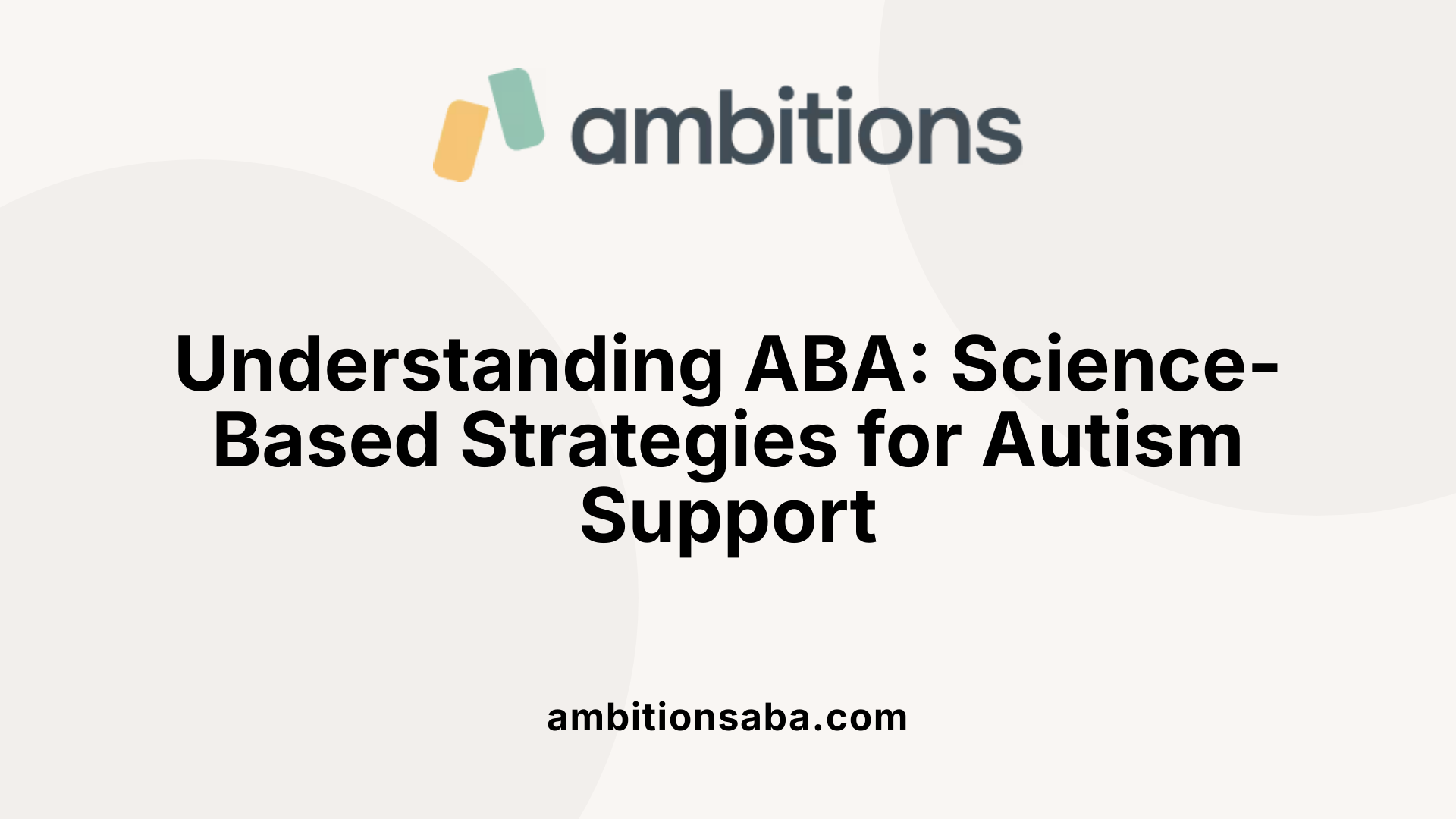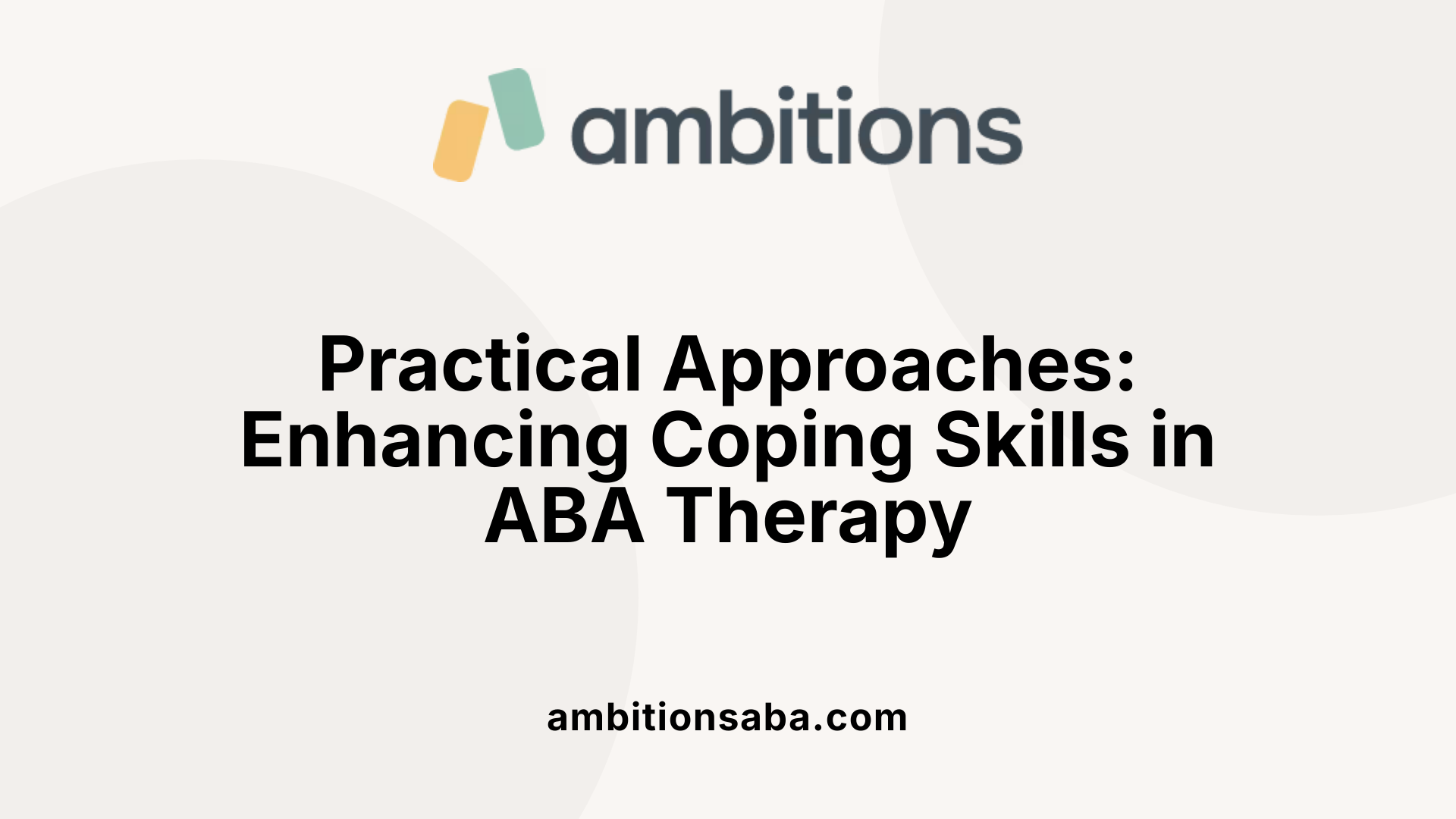Navigating Parental Burnout in the Journey of Autism Therapy
Understanding ABA Therapy and Its Role in Autism Support
Applied Behavior Analysis (ABA) therapy offers a science-backed, personalized approach to help individuals with autism develop essential skills and manage behaviors effectively. This article explores how ABA is used specifically to teach coping strategies, improves quality of life, and supports both children and families on the autism journey.
What is Applied Behavior Analysis (ABA) Therapy and How Does It Work for Autism?

Definition of ABA therapy
Applied Behavior Analysis (ABA) therapy is an evidence-based approach designed to help individuals with autism spectrum disorder improve various skills and reduce challenging behaviors. It relies on analyzing and modifying behavior through scientific principles.
Operant conditioning and behavior analysis
ABA is rooted in operant conditioning, which studies how behaviors are influenced by their consequences. By understanding triggers and results of behaviors, therapists can shape positive actions.
A-B-C framework (Antecedent-Behavior-Consequence)
The core of ABA involves the A-B-C model: identifying what happens before a behavior (Antecedent), the behavior itself, and what follows (Consequence). This framework helps determine patterns and effective interventions.
Positive reinforcement and behavior modification
Positive reinforcement is used extensively to encourage desired behaviors by rewarding them, which increases their likelihood of recurrence. This strategy forms the foundation of behavioral change in ABA.
Personalization of treatment plans
Trained Board Certified Behavior Analysts (BCBAs) create individualized treatment plans tailored to the unique strengths and needs of each child, focusing on areas like communication, social skills, self-care, and academics.
Settings for delivery (home, school, community)
ABA therapy is versatile and can be delivered across various environments, including the home, school, and community settings. Flexible delivery ensures learning happens naturally and is generalized across contexts.
Focus on communication, social skills, self-care, academics
ABA interventions target critical developmental domains such as improving language abilities, teaching social interaction skills, enhancing daily living tasks, and supporting academic learning.
Overall, ABA therapy offers a structured, compassionate approach that uses behavior science to promote independence and meaningful participation for children with autism.
The Professional Landscape of ABA Therapy Providers

Who typically provides ABA therapy and what qualifications do professionals need?
ABA therapy is commonly delivered by a variety of trained professionals who specialize in behavior science and autism support. These include board-certified behavior analysts (BCBAs), registered behavior technicians (RBTs), behavior therapists, and other specialized clinicians.
Types of ABA professionals
- Board-Certified Behavior Analysts (BCBAs): These are advanced-level practitioners who design and oversee ABA programs.
- Registered Behavior Technicians (RBTs): Paraprofessionals who implement ABA interventions under supervision.
- Behavior Therapists: Often hold master's degrees and provide therapy using ABA principles.
Qualifications required for ABA providers
To become a qualified ABA provider, individuals typically start with a bachelor’s degree in psychology, education, or a related field. Most then pursue a master's degree specializing in applied behavior analysis or an associated discipline.
Degree requirements and certifications
Graduate coursework tailored to ABA principles is essential, combined with substantial supervised fieldwork—typically between 1,500 to 2,000 hours. After completing education and practicum requirements, candidates must pass a rigorous certification exam.
The BCBA credential and BACB certification
The Behavior Analyst Certification Board (BACB) administers the BCBA certification, a widely recognized credential that signifies professional competence. Receiving this credential involves meeting educational and experience standards and successfully passing the BCBA exam.
Supervised fieldwork and examination process
Supervised practical experience allows candidates to apply ABA techniques under expert guidance, ensuring readiness for independent practice. Once fieldwork is completed, professionals take the BACB exam to achieve certification.
State licensure and additional training
Many practitioners obtain state licensure that may impose further education, supervision, or testing standards, ensuring compliance with local regulations. Additional training can include master's certificates and doctoral credentials for advanced practice.
Key skills and professional traits necessary for ABA practitioners
Successful ABA providers exhibit exceptional observational and analytical skills along with clear communication abilities. Patience, ethical integrity, and a genuine passion for helping individuals facing developmental or behavioral challenges are essential traits.
This professional landscape ensures that individuals seeking ABA therapy receive care from well-qualified experts committed to effective and ethical treatment.
Designing Individualized ABA Therapy Programs for Coping Skills

How is an ABA therapy program designed and customized for individual needs?
ABA therapy programs start with comprehensive assessments by Board Certified Behavior Analysts (BCBAs) or therapists to understand a child’s specific strengths, challenges, and interests. These detailed evaluations help identify behaviors to target, such as communication improvements, social skills, or reduction of anxiety-related responses.
Once assessments are complete, a personalized treatment plan is developed. This plan breaks down complex skills into manageable, teachable steps. Reinforcement strategies, such as rewards and positive feedback, are used to encourage desired behaviors and coping skills. The therapy often incorporates play-based and functional activities to keep children engaged while helping them generalize skills to real-life scenarios.
Therapy settings are tailored to suit individual needs. Sessions may take place in clinics, homes, schools, or community environments depending on what best supports the child’s progress. Continuous data collection during therapy allows the behavior analyst to track progress closely and make ongoing modifications to the plan as needed.
Family involvement is essential throughout this process. Caregivers receive training to apply ABA strategies consistently across different environments, reinforcing development outside of therapy sessions. This collaboration enhances the child’s ability to use coping skills in daily life and helps maintain gains long-term.
The Evidence Base: Effectiveness of ABA Therapy in Autism Intervention
What is the evidence supporting the effectiveness of ABA therapy for autism?
There is substantial scientific evidence supporting the effectiveness of Applied Behavior Analysis (ABA) therapy for individuals with autism spectrum disorder (ASD). Numerous scientific studies, including rigorous meta-analyses, have consistently demonstrated that ABA significantly improves social, communication, and cognitive skills in children with autism.
Notably, large effect sizes have been reported for gains in IQ and expressive language abilities following ABA interventions. Research from 2024 emphasizes that these improvements are especially pronounced when ABA is implemented early in childhood and involves intensive training.
Long-term benefits of ABA therapy have also been documented. Children receiving ABA show sustained progress in adaptive behaviors such as daily living skills and emotional regulation. These outcomes support ABA's role in fostering greater independence and quality of life.
Parental involvement plays a critical role in optimizing ABA outcomes. Active parent training and support enhance skill generalization and reinforcement outside therapy settings, leading to more durable improvements.
Because of the strong and consistent evidence, ABA therapy is widely regarded as the gold standard for autism treatment. It remains the most validated behavioral intervention for promoting developmental gains and functional skills in children with ASD.
Teaching Coping Strategies with ABA: Core Behavioral Techniques
What Behavioral Strategies Are Used to Teach Coping Skills?
Applied Behavior Analysis (ABA) employs behavioral strategies that focus on teaching functional coping mechanisms through reinforcement. By systematically rewarding positive behaviors, ABA helps individuals learn healthier alternatives to replace problematic or anxiety-inducing reactions.
How Does Positive Reinforcement Work in Teaching Alternatives?
Positive reinforcement involves providing rewards or encouragement when desired coping behaviors occur. This increases the likelihood these behaviors will be repeated, creating effective and lasting coping skills.
What Techniques Like Cognitive Restructuring and Desensitization Are Used?
ABA integrates cognitive restructuring by helping individuals identify and change negative thought patterns contributing to anxiety. Desensitization, particularly gradual exposure to anxiety triggers paired with positive reinforcement, reduces unhealthy responses. For example, a person may be progressively exposed to feared stimuli to build tolerance and decrease avoidance.
How Are Relaxation Techniques Incorporated to Reduce Anxiety?
Relaxation methods such as deep breathing, progressive muscle relaxation, and mindfulness exercises are taught within ABA to help manage physiological stress responses. These skills are reinforced and practiced regularly to improve anxiety control.
What Is the Role of Exposure Therapy and Gradual Desensitization?
Exposure therapy, a cornerstone of ABA for anxiety, involves gradually and safely introducing anxiety-provoking stimuli or situations. This reduces fear responses over time by allowing the individual to build coping skills in manageable steps.
How Does Behavior Analysis Help Reduce Problematic Behaviors?
By examining the causes and consequences of behaviors, ABA helps identify triggers and reinforces alternative, acceptable responses. This systematic approach effectively reduces maladaptive behaviors and promotes adaptive coping.
How Is ABA Integrated with Cognitive Approaches Like CBT?
Blending ABA with cognitive therapies such as Cognitive Behavioral Therapy (CBT) enhances treatment outcomes. ABA’s behavioral techniques complement CBT’s focus on thought patterns, collectively addressing both the behavior and cognition underlying issues like anxiety.
Addressing Anxiety and Emotional Regulation through ABA
How does ABA identify and reduce anxiety triggers?
ABA therapy starts with comprehensive assessments to pinpoint specific triggers that cause anxiety. This often involves observing behaviors like hand wringing, pacing, or crying in autistic children and collecting parent reports. By understanding these triggers, ABA practitioners develop tailored interventions aimed at reducing their occurrence and minimizing anxious responses.
What role does desensitization play in managing anxiety?
Desensitization is a core ABA technique involving gradual and controlled exposure to stressful stimuli. This step-by-step process helps decrease anxiety reactions over time, especially in children who may otherwise avoid challenging situations. For example, introducing a child slowly to a feared social setting allows them to build tolerance without becoming overwhelmed.
How are relaxation and coping techniques taught through ABA?
ABA therapists incorporate methods like cognitive restructuring and direct teaching of relaxation techniques. These approaches equip individuals with strategies to manage anxiety symptoms, such as deep breathing exercises or guided imagery, promoting self-regulation during stressful moments.
How do behavioral rewards and visual supports assist in treatment?
Reinforcement through rewards encourages participation and positive behavior change, making learning new coping mechanisms effective. Visual supports—as in schedules, social stories, and emotion recognition charts—help clarify expectations and aid children in understanding and managing their feelings.
In what ways does ABA reduce social anxiety in school settings?
ABA has demonstrated effectiveness in easing social anxiety by targeting specific anxieties related to classroom and peer interactions. Social skills training is provided to navigate situations like group work or discussions about sensitive topics. Creating sensory-friendly spaces and using visual schedules help reduce overwhelm in school environments.
How are behavioral signs of anxiety monitored in autistic children?
Monitoring involves systematic observations of behaviors indicating distress or sensory sensitivities. These behavioral markers guide adjustments in therapy plans and help track progress over time, ensuring interventions remain responsive to the child's needs.
Why is parental involvement important in ABA anxiety interventions?
Parents play a vital role by reinforcing strategies at home and providing consistent support. Ongoing parent training and collaboration ensure that coping techniques and behavioral supports are generalizable across environments, boosting the overall effectiveness of treatment programs.
Supporting Children with Autism During Grief Using ABA Strategies
Assessing grief impact on behaviors
ABA therapists or Board Certified Behavior Analysts (BCBAs) begin by conducting comprehensive assessments to understand how grief affects a child's behavior. This often includes observation and gathering parent reports about behaviors such as increased pacing, hand wringing, crying, or sensory sensitivities, which can indicate emotional distress.
Developing individualized plans to address grief
Based on assessments, therapists create tailored intervention plans that focus on managing emotional and behavioral responses to grief. These plans incorporate self-regulation techniques and coping strategies suited to each child's needs.
Teaching communication strategies about grief
To help children express their feelings, ABA therapy emphasizes teaching various communication methods. This includes using picture exchange systems, sign language, or augmentative and alternative communication (AAC) devices, enabling children to share thoughts and emotions related to grief effectively.
Emotion recognition and labeling
ABA therapists employ visual supports, social stories, and role-playing activities to help children identify and label their emotions. This approach enhances emotional understanding and supports healthier expressions of grief.
Sensory regulation during grief
Grieving can intensify sensory sensitivities in children with autism. ABA incorporates sensory regulation strategies to manage these sensitivities, helping children maintain comfort and reduce emotional overwhelm during the grieving process.
Social skills training for grief-related situations
ABA therapy includes social skills development to prepare children for grief-associated social interactions such as attending funerals or participating in conversations about loss. Practice and modeling improve their ability to navigate these settings.
Maintaining routines to reduce anxiety
Consistency is vital; maintaining predictable daily routines helps minimize disruption and anxiety. ABA programs encourage families to keep familiar schedules, providing stability during emotionally challenging periods.
Creating visual supports and social stories
Visual supports and personalized social stories explaining grief and related events are practical tools used in ABA to aid comprehension and emotional coping. These resources make abstract concepts more concrete and manageable for children.
Professional support importance
ABA stresses the necessity of collaboration with experienced health professionals to address the complex emotional needs of grieving children effectively. Multidisciplinary support ensures comprehensive care.
These ABA strategies collectively provide a compassionate and structured framework to support children with autism through grief, fostering emotional resilience and communication.
Parental Involvement: A Pillar for Successful ABA Programs
Why is ongoing parent training and support important?
Ongoing parent training and support are crucial for the success of Applied Behavior Analysis (ABA) programs. Parents learn to understand the therapeutic strategies and how to apply them consistently at home, which extends the benefits of therapy beyond clinical sessions.
What roles do parents play in reinforcing coping strategies?
Parents reinforce coping strategies by encouraging and practicing the skills taught during therapy. This constant reinforcement helps children generalize new behaviors across different environments, making progress more sustainable.
How are families taught behavior modification techniques?
Therapists guide families in behavior modification techniques such as positive reinforcement, structured routines, and visual supports. These empower parents to manage challenging behaviors effectively and promote desired behaviors through consistent application.
What are the benefits of consistent home and therapy practice?
Consistency between home and therapy sessions results in steadier progress. Children receive clear, predictable messages about expected behaviors, which reduces anxiety and confusion, supporting emotional regulation and skill mastery.
How is collaboration built between therapists and families?
Therapists actively communicate with families, providing regular feedback, resources, and coaching. This partnership ensures treatment plans are tailored to the child's unique needs and that parents feel supported and confident.
How does ABA empower caregivers to handle challenging behaviors?
By equipping caregivers with practical tools and strategies, ABA therapy ensures they can effectively address difficult behaviors and support emotional coping. Empowered parents become advocates and skilled facilitators in their child's developmental journey.
The Collaborative Approach: Integrating ABA with Speech and Occupational Therapies
Complementing ABA with Speech Therapy
Applied Behavior Analysis (ABA) is often paired with speech therapy to address communication challenges, especially in children with autism. While ABA targets behavior modification and teaches functional alternatives, speech therapy focuses on developing verbal and nonverbal communication skills. This dual approach allows children to express emotions such as grief more effectively through techniques like picture exchange systems, sign language, or augmentative and alternative communication (AAC) devices.
Addressing Communication Challenges Collaboratively
ABA therapists and speech-language pathologists work together to help children recognize, label, and communicate their feelings. Using visual supports, social stories, and role-playing, therapists facilitate the understanding of complex emotions while encouraging active expression. This collaboration ensures that communication barriers do not hinder emotional processing and coping.
Occupational Therapy to Aid Sensory Regulation and Self-Control
Occupational therapy complements ABA by focusing on sensory integration and self-regulation skills. Sensory sensitivities, which can worsen during stressful times such as grieving, are managed with tailored strategies. Occupational therapists help children develop coping mechanisms that reduce anxiety and improve attention, supporting smoother behavioral interventions under ABA.
Enhancing Self-Regulation and Emotional Coping
Together, ABA, speech therapy, and occupational therapy lay the groundwork for improving self-regulation and emotional coping. ABA techniques guide behavior modification, occupational therapy targets sensory and emotional control, and speech therapy enhances communication skills. This integrated effort helps children better manage grief, anxiety, and other emotional challenges.
Coordinated Interventions for Holistic Development
Coordinated services ensure that all areas of a child's needs are addressed simultaneously. Maintaining routines, creating sensory-friendly spaces, and developing individual treatment plans based on comprehensive assessments allow for holistic care. This multidisciplinary approach maximizes treatment effectiveness in clinical, school, and home settings.
Benefits of Multi-Disciplinary Teamwork
Multi-disciplinary teamwork provides multiple perspectives, encourages information sharing, and supports consistent strategies across environments. It helps reduce anxiety and promotes skill generalization. Families benefit from cohesive therapy plans and ongoing parent training, all contributing to more successful outcomes in behavioral and emotional development.
Historical Context: Roots of Behavior Analysis in Psychotherapy
Origins of ABA Tracing Back to 1930s
Applied Behavior Analysis (ABA) has its beginnings in the 1930s, emerging from the scientific study of operant conditioning. This foundation provided a systematic approach to understanding and modifying behavior through reinforcement and consequences.
Operant Conditioning Foundations
At the core of ABA lies operant conditioning, a concept developed to explain how behaviors are learned and maintained based on their outcomes. This principle allowed therapists to create targeted interventions by reinforcing desired behaviors and reducing unwanted ones.
Early Behavioral Therapy Pioneers, Like Joseph Wolpe
In the mid-20th century, pioneers such as Joseph Wolpe advanced behavioral therapy by introducing techniques like desensitization and systematic exposure. These methods were revolutionary in treating conditions like PTSD, phobias, and anxiety disorders.
Use of Desensitization and Systematic Exposure for PTSD, Anxiety, Phobias
Desensitization involved gradually exposing patients to anxiety-provoking stimuli while pairing exposure with positive reinforcement. This progressive approach helped reduce negative emotional reactions and increased tolerance to triggers.
Evolution of Behavioral Strategies in Psychotherapy
Over the years, behavioral approaches expanded to include teaching coping mechanisms using reinforcement techniques. This evolution improved behavior modification, especially for psychological challenges.
Blending Behavioral with Cognitive Therapies
Behavior analysis was further enhanced by integrating cognitive therapy principles, giving rise to approaches like cognitive behavioral therapy (CBT). This blending improved treatment efficacy by addressing both thoughts and behaviors.
Application to Diverse Psychological Disorders
Today, behavioral and cognitive therapy combinations effectively treat a range of disorders, including depression, OCD, PTSD, anxiety, eating disorders, borderline personality disorder, and addiction, highlighting the broad impact of these evolving methods.
Key Practical Strategies to Support Coping Skills in ABA Therapy

Use of Visual Supports and Social Stories to Teach Coping
Visual supports and social stories are vital tools in ABA therapy that help children understand and manage emotional responses. These resources simplify abstract feelings, making it easier for children to recognize emotions and learn appropriate coping strategies.
Creating Sensory-Friendly Therapeutic Environments
ABA therapy incorporates sensory regulation strategies tailored to individual needs. Establishing sensory-friendly spaces allows children to feel safe and reduces overwhelm, which aids in managing anxiety and other emotional challenges.
Maintaining Predictable Routines to Reduce Anxiety
Maintaining routines and providing predictability are crucial components in reducing anxiety during therapy and everyday life. Structured schedules help children anticipate what to expect, minimizing feelings of uncertainty and stress.
Role-Playing and Modeling Emotional Responses
Therapists use role-playing and modeling to teach children how to identify and express emotions effectively. These interactive techniques build social understanding and prepare children for real-life emotional situations.
Teaching Self-Regulation Techniques
Self-regulation strategies are taught to help children manage challenging behaviors and emotional reactions. Techniques include relaxation methods, coping skills, and gradual exposure to stressors.
Setting Up Reinforcements to Increase Participation
Positive reinforcement encourages desired behaviors and increases engagement in therapy sessions. Reward systems and visual prompts motivate children to participate actively and practice learned coping skills.
Creating Supportive, Structured Learning Spaces
Structured learning environments provide consistency and clear expectations, which support successful skill acquisition. These spaces incorporate behavioral strategies and create an atmosphere conducive to growth and emotional development.
The Transformative Impact of ABA on Coping and Independence
Applied Behavior Analysis therapy stands as a transformative, evidence-based approach that equips children with autism with essential coping skills to navigate emotional challenges, anxiety, and grief. Through personalized, data-driven programs facilitated by qualified professionals and strong family collaboration, ABA fosters communication, emotional regulation, and behavioral improvements that support lifelong independence and well-being. Its integration with complementary therapies and emphasis on practical strategies underscores its holistic potential to empower both individuals and their families on the path toward meaningful, resilient living.
References
- Applied Behavior Analysis in Psychotherapy, Treating Autism!
- Can ABA Therapy Help with Anxiety? In Many Cases, Yes
- Discover Effective Applied Behavior Analysis in Riverside
- The effectiveness of applied behavior analysis program ...
- Efficacy of Interventions Based on Applied Behavior ...
- Applied Behavior Analysis (ABA)
- The effectiveness of applied behavior analytic interventions ...

